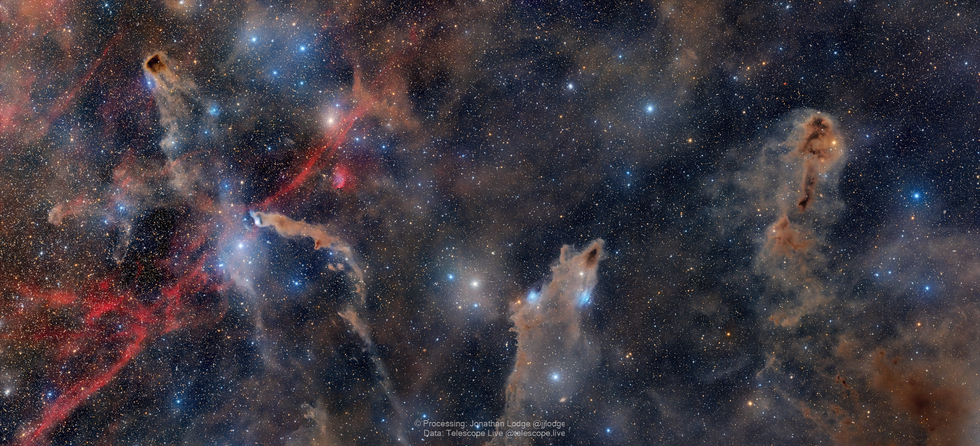Wolf's Cave, Dark Shark and Rotten Fish Mosaic
Wolf's Cave, Dark Shark and Rotten Fish Mosaic
The Wolf's Cave Nebula [left] gets it's name from the German astronomer
Max Wolf (1863 – 1932), who believed that the complex looked like a cave, hence it became known as 'Wolf's Cave'. Max Wolf's assistant, August Kopff, photographically discovered the complex structure on October 21, 1908. At the centre is the blue reflection nebula, Cederblad 201. The extended dark nebula is cataloged as Barnhard 175. Together,
they are known as Van den Bergh 152.
To the lower right is the ancient planetary nebula Dengel-Hartl 5. The red filaments, extending across the image, are part of the huge supernova remnant SNR 110.3+11.3.
The Dark Shark Nebula [centre] (aka LDN 1235) is a dark nebula about 650 lights years away. Dark dust like that featured here is somewhat like cigarette smoke and created in the cool atmospheres of giant stars.
The Rotten Fish Nebula [right] (aka LDN 1251) is a dark nebula about
1000 light years away from Earth.
3 panel mosaic with a total integration time of 31 hours.
Max Wolf (1863 – 1932), who believed that the complex looked like a cave, hence it became known as 'Wolf's Cave'. Max Wolf's assistant, August Kopff, photographically discovered the complex structure on October 21, 1908. At the centre is the blue reflection nebula, Cederblad 201. The extended dark nebula is cataloged as Barnhard 175. Together,
they are known as Van den Bergh 152.
To the lower right is the ancient planetary nebula Dengel-Hartl 5. The red filaments, extending across the image, are part of the huge supernova remnant SNR 110.3+11.3.
The Dark Shark Nebula [centre] (aka LDN 1235) is a dark nebula about 650 lights years away. Dark dust like that featured here is somewhat like cigarette smoke and created in the cool atmospheres of giant stars.
The Rotten Fish Nebula [right] (aka LDN 1251) is a dark nebula about
1000 light years away from Earth.
3 panel mosaic with a total integration time of 31 hours.
SPECIFICATIONS
Telescope
Takahashi FSQ-106 Spa-1
Camera
FLI 16803
Location
IC Astronomy Observatory, Oria, Spain
Date of observation
Jan - Oct 2022
Filters
Astrodon HLRGB
Processing
PixInsight, APP, GraXpert, RC Astro Tools, Photoshop
Credits
Data: Telescope Live, Processing: Jonathan Lodge
Comments
That is outstanding - superb processing.
Thank you very much David!



